Did you know over half of U.S. pets struggle with weight? Nearly 56% of dogs and 60% of cats are overweight or obese. This shows how pet nutrition choices affect their health.
Proper pet care begins with knowing your pet’s needs. Puppies under 12 weeks need three meals a day. But by six months, they only need two meals to avoid overeating1. Free-feeding can lead to obesity, while scheduled meals help control calories1.
Even foods meant for humans, like chocolate or onions, can be harmful. Always choose foods with the AAFCO seal for safety12.
Key Takeaways
- Over 50% of pets are overweight, stressing the need for pet nutrition awareness.
- Free-feeding increases obesity risks1.
- AAFCO-labeled foods ensure balanced diets1.
- Cats need warm, meat-based meals to avoid digestive issues1.
- Human foods like chocolate or onions are toxic12.
Understanding Your Pet’s Nutritional Needs
Pet health and animal wellness depend on diets that fit their needs. Cats need high-protein diets because they are meat-eaters. Dogs, on the other hand, need a mix of nutrients from different sources.
Their life stages and how active they are also affect what they need to eat.
Different Dietary Needs by Species
- Cats need taurine from meat because they can’t get it from plants3.
- Dogs can digest carbs well, and dry foods with 30-60% starch give them enough energy3.
Age and Activity Level Considerations
Puppies need 25% more calories than adult dogs to grow4. Active dogs might need diets with lots of energy since they burn over 900 calories a day. Also, over 50% of U.S. pets are overweight, showing the importance of the right amount of calories5. Senior pets might need fewer calories but more nutrients for their joints, like glucosamine.
Common Nutritional Myths
Myth: Grain-free diets are always better. Fact: Grains give pets fiber and energy, and most pet obesity comes from bad diet choices5. Myth: Homemade diets are always better. Reality: Too much vitamin A can harm bones, and 85% of pet owners think their homemade meals are balanced when they’re not54.
Choosing the Right Pet Food
Finding the best pet food means balancing convenience, nutrition, and your pet’s special needs. A good diet should have over 40 essential nutrients, fitting their life stage6. Talking to a vet can help with tough choices, especially for pets with health problems6.
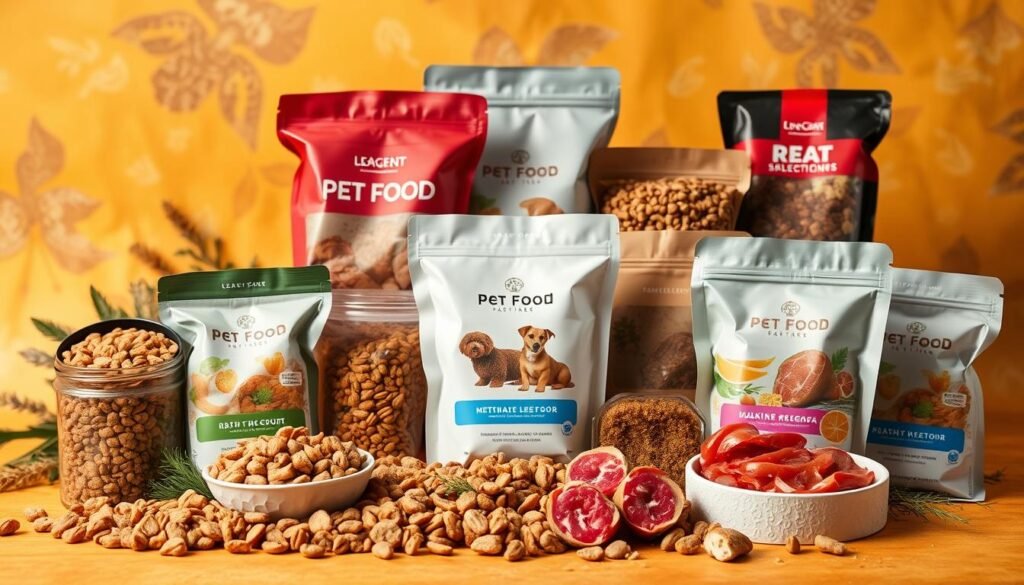
- Dry Food: It’s affordable and helps keep teeth clean. Choose foods with named meats like chicken or beef, not vague terms like “meat by-products”6.
- Wet Food: It has a lot of moisture (up to 80%), which is great for cats who need to stay hydrated7.
- Raw Diets: They’re popular but need careful handling. Cooked and commercial raw options might be more digestible (up to 98%)8.
Quality ingredients are key. Look for real proteins like salmon or turkey at the top of the list. Stay away from artificial preservatives or fillers like corn or soy. Cats need 40-45% protein, while dogs need at least 18%7. Make sure the product meets AAFCO standards for your pet’s life stage8.
Don’t choose foods with generic terms like “meat meal” or too much salt. Treats and supplements aren’t full diets—they lack the balance of pet nutrition6. Dry foods digest at 80%, while homemade can reach 98% digestibility8.
If you’re unsure, reach out to veterinary services for personalized advice. They can adjust diets for allergies or health issues, making sure your pet does well6.
Understanding Pet Food Labels
Reading pet food labels is crucial for pet care. These labels show what’s in the food, helping keep your pet healthy. The Association of American Feed Control Officials (AAFCO) makes it easier to compare different brands9. Let’s look at how to understand each part.
“Nutritional adequacy claims must align with AAFCO’s nutrient profiles for growth, reproduction, or maintenance diets.”
Ingredients are listed by weight before cooking9. High-moisture meats like chicken might be first but have less protein after cooking. AAFCO’s rules help clarify this:
- “95% Rule: “Beef Dinner” must have at least 70% beef by weight9.
- “25% Rule: “Lamb Recipe” needs 25% lamb in the final product9.
Look for phrases like “complete and balanced” backed by AAFCO’s nutrient profiles. Dog foods need 37 nutrients, while cats require 449. Statements must say if it’s for all life stages or for puppies9.
This section lists minimum and maximum values for protein, fat, fiber, and moisture. Wet food has more moisture, so compare dry-matter content. For example, dry kibble might list 23% protein, but canned food shows 6%. But dry matter shows the real values10. Always check fiber levels to avoid digestive problems9.
Feeding Guidelines for Dogs
Starting a healthy pet nutrition plan means knowing your dog’s ideal weight and activity level. With 59% of dogs overweight in the U.S., it’s crucial to follow portion guidelines to avoid health risks11. Here’s how to feed dogs of all sizes right.
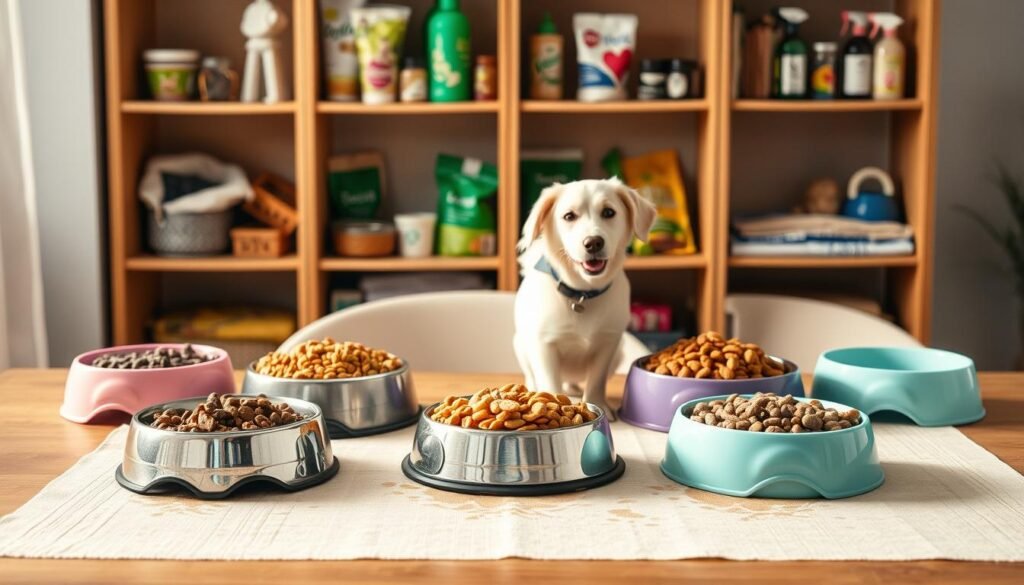
- 3–12 lbs: ½–1¼ cups daily11
- 13–20 lbs: 1¼–1⅔ cups11
- 21–35 lbs: 1⅔–2⅓ cups11
- 36+ lbs: Adjust based on weight and activity. Giant breeds over 100 lbs need 4⅔ cups plus ⅓ cup per extra 10 lbs11
Puppies need more meals to grow. Feed them 3–4 times a day until they’re 6 months old, then switch to twice a day for adults11. Small breeds like Chihuahuas or toy breeds might need extra meals to avoid low blood sugar. Large breeds like Great Danes need special formulas to prevent joint problems11.
“Treats should never exceed 10% of daily calories. Use them to reinforce puppy training commands like ‘sit’ or ‘stay,’” advises the American Kennel Club11.
Adjust portions for different life stages. Pregnant or senior dogs might need more protein or fewer calories. Always base portions on their ideal weight, not their current weight. For example, a 50-lbf German Shepherd adult needs 2⅔–3 cups daily11. Keep track of treats closely—choose carrot sticks or apple slices instead of high-calorie snacks11.
Feeding Guidelines for Cats
Cats need a precise diet to stay healthy. They are meat-eaters and need proteins and taurine for their heart and eyes12. Too much food can make them overweight, a problem for 41% of cats in a UC Davis study13. Knowing what they need is key to their well-being.
How much food a cat needs depends on its lifestyle. Indoor cats burn fewer calories than outdoor ones, needing 25–35 calories per pound daily13. A 10-pound indoor cat might need 250 kcal, while active outdoor cats may need more. Spayed or neutered cats need 15–20% fewer calories13. Too much food can harm their joints and organs.
“Obesity is the most common nutritional disorder in cats, affecting over 40% of pets.”
- Senior cats over 7 years need 20–30% fewer calories but higher digestibility for aging organs13.
- Food preferences often stem from instinctual tastes—cats prefer meat-flavored diets12.
- When using cat boarding services, inform caretakers of your cat’s routine to avoid digestive stress12.
Feed your cat twice a day and limit treats to 10% of their daily food. Always check with your vet before changing their diet, especially for seniors or cats with health issues. Following these tips helps keep your cat healthy and prevents problems like urinary tract issues12.
Dealing with Food Allergies
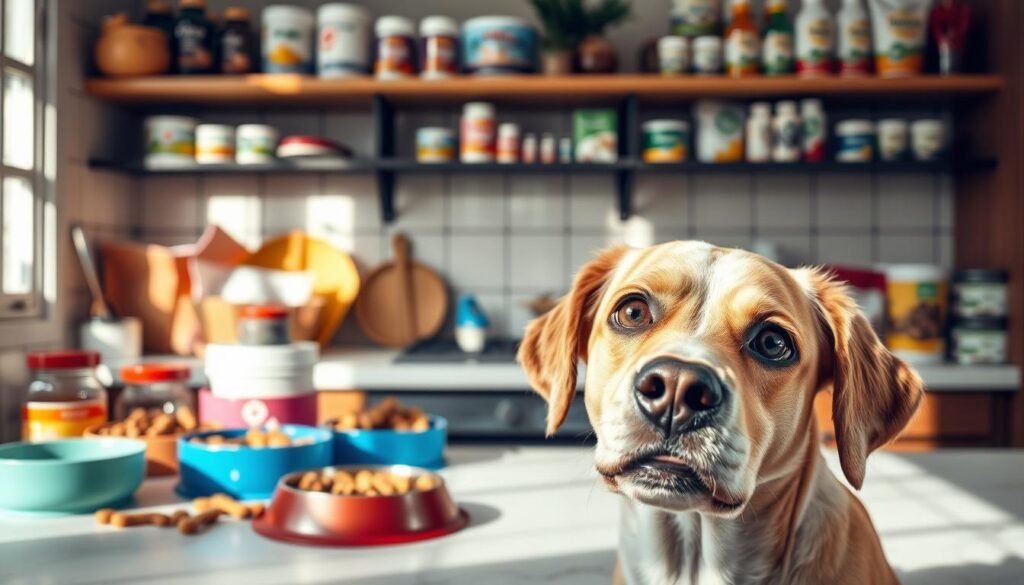
Food allergies can really upset your pet’s health. They can make your pet feel uncomfortable and tired. It’s important to spot these allergies early and get help from veterinary services.
Common Allergies in Pets
Proteins like chicken, beef, and dairy often cause allergies. Grains like wheat and soy can also be troublemakers14. Eggs and soy are common allergens too15. These problems usually start after your pet eats the same foods for a long time14.
Recognizing Allergy Symptoms
- Itching, especially around the ears, paws, and anal area14
- Ear infections keep coming back14
- Diarrhea or vomiting in 30% of affected pets16
- Excessive licking or hair loss14
Transitioning to Hypoallergenic Diets
Switching to hypoallergenic foods slowly is key. Here’s how to do it:
- Get your vet’s advice on a hydrolyzed or novel protein diet15.
- Stick to the new diet for 8–12 weeks15.
- Watch for symptoms each week and don’t give treats or table scraps16.
| Step | Action | Timeline |
|---|---|---|
| 1 | Consult veterinary services for diagnosis | Immediate |
| 2 | Start elimination diet | Week 1 |
| 3 | Track symptom changes | Week 4–12 |
If your pet feels better, keep them on the diet. If they get sick again quickly, it means they’re allergic16. Always work with a vet to make sure the diet is right for your pet.
Homemade Pet Food: Is It Safe?
Making meals at home gives pet owners control over their pet’s diet. But, creating balanced pet nutrition needs expertise. Many owners want to avoid preservatives or tailor meals for health reasons, but there are risks.
Studies show most homemade recipes are nutritionally incomplete and potentially dangerous17.
Pet care experts say dogs need 40 essential nutrients for health17. Many DIY diets lack important vitamins like taurine for cats or calcium for dogs. Dogs need proteins, carbs, healthy fats, and minerals. Cats require animal-based proteins and taurine. Without these, pets can suffer from malnutrition or obesity17.
- Dogs: Chicken, sweet potatoes, and spinach provide balanced nutrients17.
- Cats: Turkey, fish, and egg yolks supply taurine and protein17.
Risks include nutrient imbalances causing diseases like heart issues from low taurine. Grain-free diets with legumes have been linked to heart conditions17. Cooking methods also change nutrient content—steaming preserves vitamins better than boiling18.
Switching to homemade meals needs vet guidance. They can suggest supplements or adjust recipes. Sudden diet changes can upset digestion; transitions should be gradual over days18. Always avoid toxic foods like chocolate or grapes18.
Commercial diets offer convenience and balance. Yet, dedicated owners can make safe meals with the right research and vet advice. Always seek professional advice to ensure pet care practices meet scientific standards.
The Importance of Fresh Water
Having clean, fresh water is key for pet health and animal wellness. Pets lose water through breathing and daily activities19. In July’s Pet Dehydration Awareness Month, keeping them hydrated is crucial to avoid kidney failure19. Dogs and cats need at least one ounce of water per pound of body weight daily20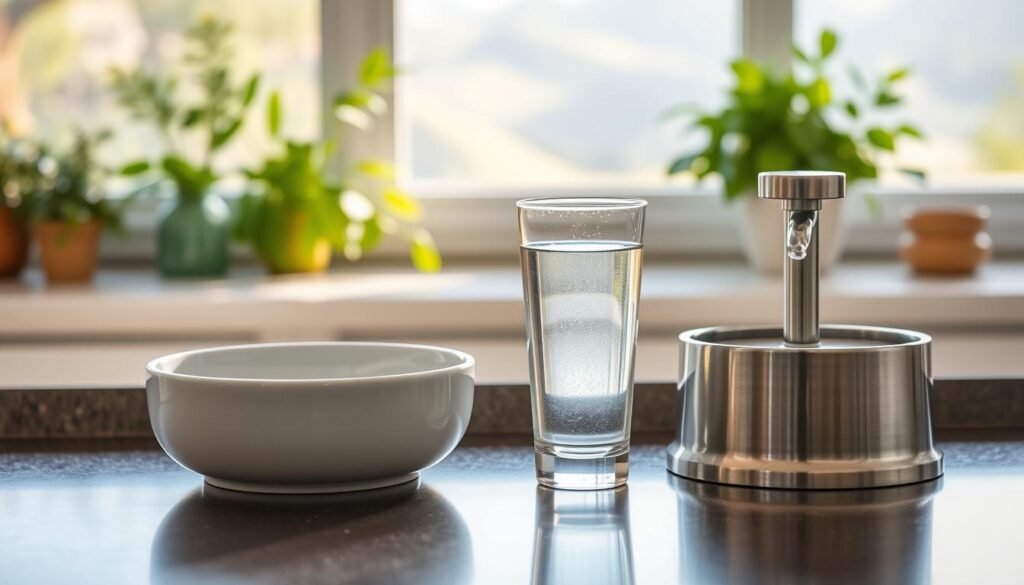
Active pets or those in warm climates need more water. Cats on dry food need extra water compared to those on wet food20. Elderly pets or breeds like Bulldogs face higher dehydration risks and need closer monitoring19. Always refill water bowls after exercise or playtime animal wellness practices21.
Refresh water twice daily and clean bowls with soap to avoid bacteria growth21. Stainless steel bowls resist germs better than plastic ones, which can harbor bacteria in scratches21. Use fountains to encourage drinking—studies show moving water attracts cats and dogs20. Track intake to ensure they meet their daily needs20.
- Slow skin elasticity: Gently pinch the neck—if it stays tented, dehydration may occur19
- Dark, concentrated urine or reduced urination19
- Lethargy, dry gums, or sunken eyes20
Severe cases require vet care to restore fluids and electrolytes19. Regular checks prevent organ strain and support long-term pet health20.
Managing Weight and Obesity
Over 56% of dogs and cats in the U.S. are overweight22. This can lead to diabetes, arthritis, and heart disease23. First, check your pet’s body condition score (BCS) on a 1–9 scale. A score of 8–9 means they are at risk23.
identifying overweight pets>
- A score of 6–7/9 means your pet is overweight but not yet obese23.
- Look for signs like trouble moving, labored breathing, or a “fat pad” over the ribs23.
healthy weight loss strategies>Work with vets to create plans. Use these steps:
- Reduce treats to 10% of daily calories24.
- Choose weight-control diets—many brands offer breed-specific options22.
- Add veggies like green beans to boost fiber and reduce calorie intake22.
importance of regular exercise>Start with 20-minute walks daily, increasing by 10% each week24. Puppies benefit from early puppy training that builds exercise routines24. Even short play sessions improve mental and physical health23.
Regular vet check-ins every two weeks track progress safely24. Small goals like losing 1% of body weight weekly add up over time24. Prioritizing pet care through diet and activity adds years to your pet’s life22.
Understanding Special Diets

Special diets are key for pets when regular food isn’t enough. Vets can create diets for pets with diabetes, allergies, or kidney disease. These diets often include prescription foods that have been tested in studies25.
Low-Carbohydrate and Grain-Free Options
- Good for pets with diabetes or grain allergies25.
- Not always needed—talk to a vet to avoid too many restrictions25.
Prescription Diets for Health Issues
Pets with long-term health issues like kidney disease do well on special diets. For example, diets for kidney disease have less phosphorus and protein to slow the disease25. Also, 56% of dogs and 60% of cats are overweight, so they might need special weight-loss diets26.
| Diet Type | Purpose | Key Ingredients |
|---|---|---|
| Renal diets | Kidney disease management | Low phosphorus, controlled protein |
| Diabetic diets | Blood sugar regulation | High protein, fiber blends |
| Hypoallergenic diets | Allergy relief | Novel proteins (duck, salmon) |
Consulting a Veterinary Nutritionist
“A board-certified nutritionist can create plans for pets with complex needs like concurrent diabetes and kidney disease.”Always get advice before starting a special diet. These experts make sure diets meet your pet’s health needs25.
Prescription diets must be used alone to work best. For example, hypoallergenic diets won’t work if mixed with other foods25. Regular vet visits are important to keep diets right as pets’ needs change.
Tips for Transitioning Between Foods
Changing your pet’s diet needs patience to keep them healthy. Quick changes can upset their stomachs. So, it’s important to take gradual steps for pet care27. Follow these tips to make the transition smooth and keep your pet well.
- Day 1-2: Mix 25% new food with 75% old food2728.
- Day 3-5: Use a 50/50 blend to help digestion adjust27.
- Day 6-7: Increase to 75% new food, then fully switch by day 7-142928.
| Pet Type | Transition Timeline | Key Steps |
|---|---|---|
| Dogs | 7 days | Start with 25% increments daily27 |
| Cats | 14 days | Begin with 1 tsp new food daily28 |
“A slow transition prevents 80% of digestive upsets during diet changes.”
Watch for signs like diarrhea, vomiting, or not wanting to eat29. If you see these, slow down the transition. Cats might need more time because they can be picky28. Keep the transition pace steady to avoid stressing them out.
Stay on schedule, even if your pet seems ready for the change. Quick changes can lead to dehydration29. Smooth transitions are key to your pet’s long-term health and happiness.
Feeding Schedules and Routines
A consistent feeding routine is key in pet care30. Dogs like knowing what to expect, which helps them feel calm and digest food better. Let’s look at how to make a schedule that fits your pet’s needs.
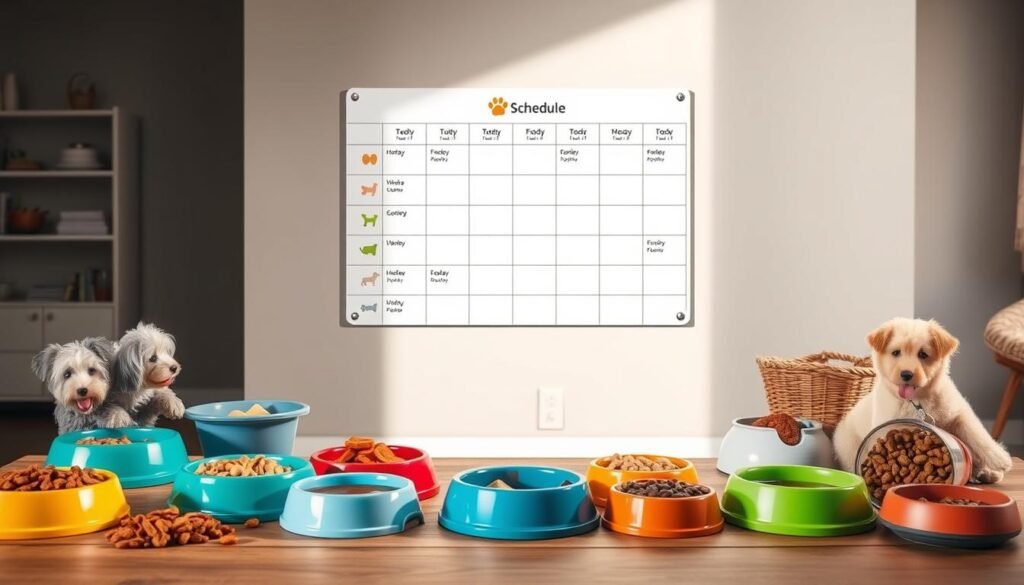
| Breed Size | Puppies (0–4 months) | Adults/Seniors |
|---|---|---|
| Toy Breeds | 4–5 meals/day31 | 2 meals/day32 |
| Small/Medium | 3 meals/day31 | 2 meals/day32 |
| Large/Giant | 3 meals/day31 | 2–3 meals/day32 |
Pro tip: Link meals to morning and evening activities like walks or playtime to add structure30. For busy owners, automatic feeders help keep feeding times consistentpet carepractices30.
“Meal timing affects bathroom habits too—dogs often go to the bathroom within 10–15 minutes after eating.”32
- Keep meals 8–12 hours apart31.
- Limit treats to 5% of daily calories31.
- Adjust for health changes: pets with GERD may need smaller, more frequent meals32.
Pet insurance might cover special diets for issues like obesity or GERD32. Being flexible is important, especially when travel messes up routines. Gradual changes help avoid stress30. Sticking to a routine builds trust and health, but being flexible is key.
Engaging with Your Pet During Meals
Making mealtime fun strengthens your bond with your pet and boosts their health. Over 70% of pet owners say it cuts down on boredom and bad habits33. Puzzle toys and scavenger hunts keep pets’ minds sharp, with 65% of dog owners using them to make meals more exciting33. For cats, these toys tap into their natural hunting drive, making them more engaged33.
Making Mealtime Fun
Puzzle feeders and interactive toys turn meals into games. This slows down eating and stops overeating. Over 40% of pet owners set up scavenger hunts for dogs, keeping them active33. These games also lower stress, helping with weight control, and fit with puppy training34.
Avoiding Food Aggression
Starting early helps stop pets from guarding food. Supervised meals and gradual exposure build trust. Keeping to a routine and removing food after 15 minutes helps pets not get too attached to meals35.
Teaching Commands Associated with Feeding
Commands like “wait” or “stay” during meals teach boundaries. These skills are key in puppy training programs34. Positive experiences during meals also make other routines, like grooming, easier34.
Using these methods together improves your pet’s health and behavior. Engaged pets are happier and more likely to follow commands, making daily care smoother. Regular interaction ensures pets do well, from mealtime to grooming33.
FAQ
What are the main differences in dietary needs for dogs and cats?
How can I tell if I’m choosing the right food for my pet?
How do I read pet food labels effectively?
What portion sizes should I feed my dog or cat?
Are there special dietary needs for senior pets?
How can I recognize if my pet has food allergies?
Is homemade pet food a safe option for my pet?
How important is hydration for my pet’s health?
What strategies can help manage my pet’s weight?
When should I consider a special diet for my pet?
How can I safely transition my pet to a new food?
Why is establishing a consistent feeding schedule important?
How can I make mealtime more engaging for my pet?
Source Links
- How to Feed Your Pet, Methods & Advice – Pet Wellness Clinics – https://petwellnessclinics.com/articles/feeding-your-pet/
- What Should I Feed My Dog | RSPCA Pet Insurance – https://www.rspcapetinsurance.org.au/pet-care/dog-care/what-should-feed-dog
- Dog Nutrition: Guide to Dog Food Nutrients – https://www.petmd.com/dog/nutrition/evr_dg_whats_in_a_balanced_dog_food
- Understanding Your Dog’s Nutritional Needs for Different Life Stages – https://www.aorvethospital.com/services/dogs/blog/understanding-your-dogs-nutritional-needs-different-life-stages
- Find Out More About the Nutrients Your Pet Needs – https://www.webmd.com/pets/dog-cat-nutrition
- Selecting the Right Pet Food – AAFCO – https://www.aafco.org/consumers/understanding-pet-food/selecting-the-right-pet-food/
- Choosing the right food for your dog or cat – https://www.animalhumanesociety.org/resource/choosing-right-food-your-dog-or-cat
- GNC_Guidelines_120421 – https://wsava.org/wp-content/uploads/2021/04/Selecting-a-pet-food-for-your-pet-updated-2021_WSAVA-Global-Nutrition-Toolkit.pdf
- Reading Labels – AAFCO – https://www.aafco.org/consumers/understanding-pet-food/reading-labels/
- Deciphering Dog Food Labels | VCA Animal Hospitals – https://vcahospitals.com/know-your-pet/deciphering-dog-food-labels
- Dog Feeding Chart: How Much Food Should I Feed My Dog? – https://www.petmd.com/dog/nutrition/are-you-feeding-your-dog-right-amount
- Nutrition – General Feeding Guidelines for Cats | VCA Animal Hospitals – https://vcahospitals.com/know-your-pet/nutrition-feeding-guidelines-for-cats
- How Much To Feed a Cat – https://www.petmd.com/cat/nutrition/how-much-to-feed-a-cat
- Food Allergies and Intolerances in Dogs – https://www.petmd.com/dog/conditions/digestive/food-allergies-dogs
- Food Allergies in Dogs | VCA Animal Hospitals – https://vcahospitals.com/know-your-pet/food-allergies-in-dogs
- Food Allergies in Dogs and Cats – https://veterinarypartner.vin.com/default.aspx?pid=19239&id=4951526
- No title found – https://www.akc.org/expert-advice/nutrition/cooking-for-your-dog-dos-and-donts/
- Homemade Dog Food: Is It Healthy to Cook for Your Dog? – https://www.petmd.com/dog/nutrition/how-make-sure-your-homemade-dog-food-delivers-right-nutrients
- The Importance of Water for Pets and Avoiding Pet Dehydration – https://www.truecareveterinaryhospital.com/blog/the-importance-of-water-for-pets-and-avoiding-pet-dehydration/
- Quenching the Thirst: Understanding the Vital Importance of Pet Hydration | Bowman Veterinary Hospital – https://www.bowmanvet.com/blog/quenching-the-thirst-understanding-the-vital-importance-of-pet-hydration/
- The Essential Guide to Fresh Water for Pets – https://www.onefurallpets.com/blogs/news/the-essential-guide-to-fresh-water-for-pets?srsltid=AfmBOoqDdbzz-1Ot5G1DXHyV1XhuFfBo5p63Fogsmi9eisId75V9e2hF
- Obesity and weight management tips – https://www.vet.cornell.edu/departments-centers-and-institutes/riney-canine-health-center/canine-health-information/obesity-and-weight-management-tips
- Guidelines for Pet Obesity Communication for Medical Professionals, Journalists, and Media — Association for Pet Obesity Prevention – https://www.petobesityprevention.org/media-guide-for-pet-obesity-communication
- Creating a Weight Reduction Plan for Dogs | VCA Animal Hospitals – https://vcahospitals.com/know-your-pet/creating-a-weight-reduction-plan-for-dogs
- Does my pet really need this special food? – Metropolitan Veterinary Associates – https://metro-vet.com/does-my-pet-really-need-this-special-food/
- Learn How to Provide Proper Nutrition for your Pet’s Specific Needs, Ensuring their Wellness Through Diet – East Coast Vets – https://eastcoastvet.com/learn-how-to-provide-proper-nutrition-for-your-pets-specific-needs-ensuring-their-wellness-through-diet/
- No title found – https://www.akc.org/expert-advice/nutrition/right-way-switch-dog-foods/
- Transitioning you dog or cat to a new diet: Tips for raw, fresh, dry or canned food – https://www.vngpets.com/post/the-picky-pet-problem-transitioning-a-dog-or-cat-onto-a-new-diet?srsltid=AfmBOorH1u9f1OZh5lT3TyRaaPgBXx0iSW5GJkSugibMRiRx4xlz8BJw
- The Ultimate Guide to Pet Diet Transition | Pet Evolution – https://www.petevolution.com/blog/how-to-transition-your-pet-to-a-healthier-diet-tips-and-tricks/
- The Importance of Establishing a Routine for Your Cat or Dog – https://www.zoetispetcare.com/blog/article/importance-routine-cat-dog
- How to Create a Feeding Schedule for Your Dog | Wellness Pet Food – https://www.wellnesspetfood.com/blog/how-to-create-a-feeding-schedule-for-your-dog/
- Feeding Times and Frequency for Your Dog | VCA Animal Hospitals – https://vcahospitals.com/know-your-pet/feeding-times-and-frequency-for-your-dog
- At-Home Tips for Keeping Your Pets Busy and Engaged – https://www.aspca.org/news/home-tips-keeping-your-pets-busy-and-engaged
- Top Pet Care Tips for a Happy and Healthy Companion | Crow Hill Veterinary Hospital – https://crowhillvet.com/top-pet-care-tips-for-a-happy-and-healthy-companion/
- Tips for Encouraging Your Pet to Eat – Mountain View Veterinary Hospital – https://mtnviewvets.com/tips-for-encouraging-your-pet-to-eat/

